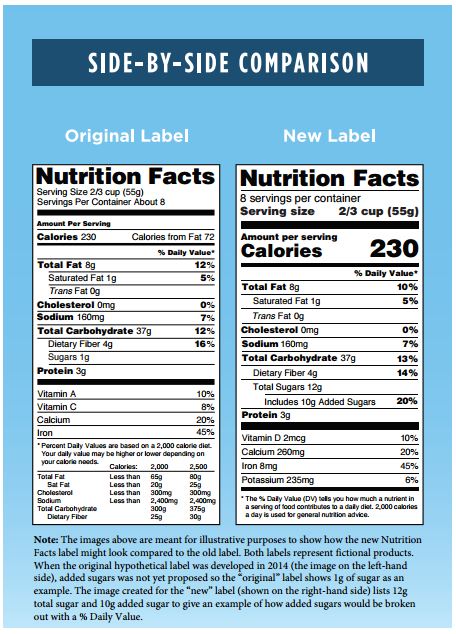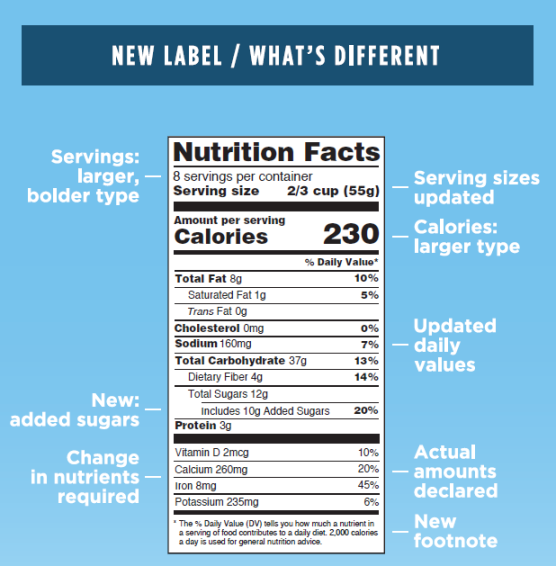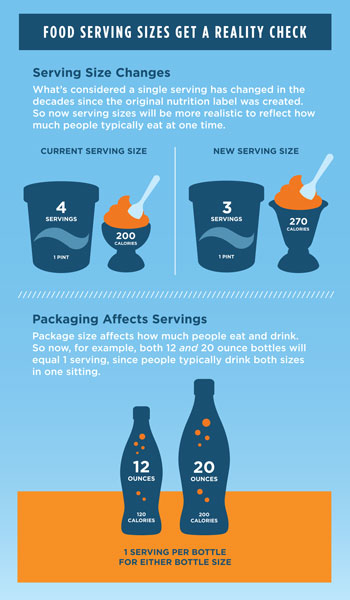Check out this side-by-side comparison of the original label and the NEW label.

The new label must be on food packages by July 26, 2018. However, food manufacturers with less than $10 million in annual food sales will have an additional year to comply (July 26, 2019).
So what’s different?

The Look:
- Calories, servings per container, and the serving size will be larger, bolder type to bring attention to this information to help people make informed decisions about the foods they eat.
- The footnote is changing to better explain what percent Daily Value means. The % Daily Value (%DV) tells you how much a nutrient in a serving of food contributes to a daily diet. 2,000 calories a day is used for general nutrition advice.
- Calories from Fat is being removed because research shows the type of fat is more important than the amount.
Daily Values:
- Daily values for nutrients like sodium, dietary fiber and vitamin D are being updated based on newer scientific evidence. The %DV helps consumers understand the nutrition information in the context of a total daily diet.
Trans Fat:
- Trans fat will be reduced but not eliminated from foods, so it will still be on the label. Artificial Trans fat are not generally recognized as safe, but some Trans fat is present naturally in food from certain animals, such as cows and goats.
Added Sugar:
- The amount of Added Sugars will be included on the label under Total Carbohydrates as a sub-category of Total Sugar. Added sugar is defined as any sugar that is added during processing and includes a pretty big list of ingredients:
-syrups
-brown sugar
-high fructose corn syrup
-invert sugar
-maltose
-trehalose
-honey
-molasses
-sucrose
-lactose
-maltose sugar
- People who eat diets with few added sugars are at a reduced risk of cardiovascular disease.
- No more than 10% of your daily calories should come from added sugar.
Nutrients of Public Health Significance:
- Vitamin D, potassium, calcium and iron are required to be listed on the label. Vitamins A and C will no longer be required but can be included on a voluntary basis.
- Manufacturers must declare the actual amount, in addition to %DV of vitamin D, calcium, iron and potassium. They can voluntarily declare the gram amount for other vitamins and minerals.
Duel Column Labeling:
- For certain products that are larger than a single serving but that could be consumed in one sitting or multiple sittings, manufacturers will have to provide “dual column” labels. This will show the amount of calories and nutrients “per serving” and “per package”. Examples include a 24 ounce bottle of soda or a pint of ice cream. People will be able to easily understand how many calories and nutrients they are getting if they eat or drink the entire package at one time.
Serving Size and Package Size:
- By law, serving sizes must be based on amounts of foods and beverages that people are actually eating, not what they should be eating. How much people eat and drink has changed since the previous serving size requirements were published in 1993. For example, a serving of ice cream used to be ½ cup, but is now ⅔ cup. A serving of soda is changing from 8 ounces to 12 ounces.
- Package size affects what people eat. So for packages that are between one and two servings, such as a 20 ounce soda or a 15-ounce can of soup, the calories and other nutrients will be required to be labeled as one serving because people typically consume it in one sitting.

The new food label is a tool that is easy to use and is helpful in showing the nutrition in the foods we consume.
Sources: U.S. Food and Drug Administration (FDA) Changes to the Nutrition Facts Label; FDA Medical Education Resources; and Federal Register Food Labeling: Revision of the Nutrition and Supplement Facts Labels.

